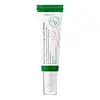What's inside
What's inside
 Key Ingredients
Key Ingredients

 Benefits
Benefits

 Ingredients Side-by-side
Ingredients Side-by-side

Water
Skin ConditioningGlycerin
HumectantNiacinamide
SmoothingSodium Hyaluronate
HumectantPropanediol
SolventErythritol
HumectantButylene Glycol
HumectantSqualane
EmollientOryza Sativa Bran Extract
Skin ConditioningCalendula Officinalis Flower Extract
MaskingCarica Papaya Fruit Extract
Skin ConditioningHippophae Rhamnoides Fruit Extract
Skin ConditioningMalpighia Glabra Fruit Extract
Skin ConditioningPolyglyceryl-10 Laurate
Skin ConditioningChlorphenesin
AntimicrobialArginine
MaskingEthylhexylglycerin
Skin ConditioningCarbomer
Emulsion StabilisingGlutathione
1,2-Hexanediol
Skin ConditioningHydroxypropyl Cyclodextrin
MaskingDisodium EDTA
Hydroxyethylcellulose
Emulsion StabilisingAllantoin
Skin ConditioningRosmarinus Officinalis Leaf Oil
MaskingWater, Glycerin, Niacinamide, Sodium Hyaluronate, Propanediol, Erythritol, Butylene Glycol, Squalane, Oryza Sativa Bran Extract, Calendula Officinalis Flower Extract, Carica Papaya Fruit Extract, Hippophae Rhamnoides Fruit Extract, Malpighia Glabra Fruit Extract, Polyglyceryl-10 Laurate, Chlorphenesin, Arginine, Ethylhexylglycerin, Carbomer, Glutathione, 1,2-Hexanediol, Hydroxypropyl Cyclodextrin, Disodium EDTA, Hydroxyethylcellulose, Allantoin, Rosmarinus Officinalis Leaf Oil
Water
Skin ConditioningCaprylic/Capric Triglyceride
MaskingTribehenin PEG-20 Esters
EmollientPEG-8
HumectantDimethicone
EmollientIsosorbide Dicaprylate
Skin ConditioningHexylresorcinol
AntimicrobialGlycerin
HumectantStearyl/PPG-3 Myristyl Ether Dimer Dilinoleate
EmollientCetyl Alcohol
EmollientGlyceryl Stearate
EmollientPEG-100 Stearate
Butylene Glycol
HumectantTocopheryl Acetate
AntioxidantArbutin
AntioxidantArctostaphylos Uva-Ursi Leaf Extract
Skin ConditioningMorus Alba Bark Extract
Skin ConditioningSalix Alba Bark Extract
AstringentPhyllanthus Emblica Fruit Extract
HumectantLecithin
EmollientHexanoyl Dipeptide-3 Norleucine Acetate
Skin ConditioningErgothioneine
AntioxidantXanthan Gum
EmulsifyingSodium Acrylates Copolymer
Triethanolamine
BufferingAmmonium Acryloyldimethyltaurate/Vp Copolymer
Propyl Gallate
AntioxidantPhenoxyethanol
PreservativeDisodium EDTA
Water, Caprylic/Capric Triglyceride, Tribehenin PEG-20 Esters, PEG-8, Dimethicone, Isosorbide Dicaprylate, Hexylresorcinol, Glycerin, Stearyl/PPG-3 Myristyl Ether Dimer Dilinoleate, Cetyl Alcohol, Glyceryl Stearate, PEG-100 Stearate, Butylene Glycol, Tocopheryl Acetate, Arbutin, Arctostaphylos Uva-Ursi Leaf Extract, Morus Alba Bark Extract, Salix Alba Bark Extract, Phyllanthus Emblica Fruit Extract, Lecithin, Hexanoyl Dipeptide-3 Norleucine Acetate, Ergothioneine, Xanthan Gum, Sodium Acrylates Copolymer, Triethanolamine, Ammonium Acryloyldimethyltaurate/Vp Copolymer, Propyl Gallate, Phenoxyethanol, Disodium EDTA
 Reviews
Reviews

Ingredients Explained
These ingredients are found in both products.
Ingredients higher up in an ingredient list are typically present in a larger amount.
Butylene Glycol (or BG) is used within cosmetic products for a few different reasons:
Overall, Butylene Glycol is a safe and well-rounded ingredient that works well with other ingredients.
Though this ingredient works well with most skin types, some people with sensitive skin may experience a reaction such as allergic rashes, closed comedones, or itchiness.
Learn more about Butylene GlycolDisodium EDTA plays a role in making products more stable by aiding other preservatives.
It is a chelating agent, meaning it neutralizes metal ions that may be found in a product.
Disodium EDTA is a salt of edetic acid and is found to be safe in cosmetic ingredients.
Learn more about Disodium EDTAGlycerin is already naturally found in your skin. It helps moisturize and protect your skin.
A study from 2016 found glycerin to be more effective as a humectant than AHAs and hyaluronic acid.
As a humectant, it helps the skin stay hydrated by pulling moisture to your skin. The low molecular weight of glycerin allows it to pull moisture into the deeper layers of your skin.
Hydrated skin improves your skin barrier; Your skin barrier helps protect against irritants and bacteria.
Glycerin has also been found to have antimicrobial and antiviral properties. Due to these properties, glycerin is often used in wound and burn treatments.
In cosmetics, glycerin is usually derived from plants such as soybean or palm. However, it can also be sourced from animals, such as tallow or animal fat.
This ingredient is organic, colorless, odorless, and non-toxic.
Glycerin is the name for this ingredient in American English. British English uses Glycerol/Glycerine.
Learn more about GlycerinWater. It's the most common cosmetic ingredient of all. You'll usually see it at the top of ingredient lists, meaning that it makes up the largest part of the product.
So why is it so popular? Water most often acts as a solvent - this means that it helps dissolve other ingredients into the formulation.
You'll also recognize water as that liquid we all need to stay alive. If you see this, drink a glass of water. Stay hydrated!
Learn more about Water